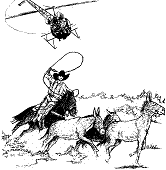Vertebrate Pest Conference: Proceedings

Vertebrate Pest Conference Proceedings: 11th (1984)
Date of this Version
March 1984
Document Type
Article
Abstract
In July 1981, efficacy data were obtained on a new two-ingredient gas cartridge by field testing against Richardson’s ground squirrels (Spermophilus richardsonii) in a sagebrush-rangeland pasture. The gas cartridge contained 97 g of a sodium nitrate (65%) and charcoal (35%) mixture and upon ignition generated mainly carbon monoxide with a small quantity of carbon dioxide. We live-trapped 53 (24 male and 29 female) ground squirrels, equipped each with a 164 MHz radio transmitter, and then released each at the point of capture. Later we located each ground squirrel and treated its main burrow and all burros within 3 m by inserting ignited gas cartridges. After treatment the location of each radio-equipped ground squirrel was plotted. Ground squirrels showing no movement were presumed dead; death was confirmed by burrow excavation. Success rate was 84% as 41 of 50 (18 males and 23 females) died (82%) and 8 survived (16%). The radio transmitter on 1 (2%) failed immediately after treatment. Efficacy was estimated at 83.7%, which exceeds the 70% minimum standard established by the EPA. Thirty-eight ground squirrels died in burrows at depths ranging from 7.6 to 132.1 cm (Χ̅ =74.7 ± SE 5.2 cm), and 3 died in nests at depths ranging from 94.0 to 182.9 cm (Χ̅ = 133.0 ± SE 26.2). Seven of the eight survivors were retrapped. Factors contributing to survival are discussed, including soil porosity and moisture content, as well as squirrel body weight. Recommendations for further testing are presented.

